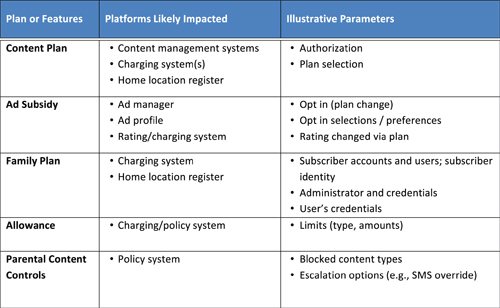|
|

But it’s the inexorable rise, and more importantly the intersection, of three big trends that test the ambition of the service factory: mobility, personalization and content.
Revisiting the Service Factory
Communications service providers are looking to satisfy individual customer demands for ever more complex services and bundles. We are making services more interactive and personalized. The more options we give consumers, and the more options we have in the network to deliver that customer experience, the exponentially more complex service provisioning and operations become.
|
|
A strong rules-based service catalog with provision-able service components is crucial. |
|


what about offering mobile video
content on an advertising subsidized
platform?
Consider the following use case, based on a not-untypical mobile broadband scenario. Walking through the provisioning process will demonstrate how the lines of interaction and managing change can quickly become tied in knots.
|
|
|
|
|

In wireless, service provisioning is no longer just an entry in a Home Location Register. Fulfillment will increasingly be about assembling service configurations and managing disparate service components that affect one another, which in turn will leverage automation and componentization to allow mass customization of low-volume (but abundant), long-tail services.
Wireless operators enjoy a service-/
parameter-based style of provisioning,
completely separated from the
underlying technology and physicality
of the supporting network. Fulfillment
in wireline is still largely characterized
by circuit facility-based ordering - a
necessity for the many networks reliant
on TDM and point-to-point connectivity.
But wireline broadband bundles and
supply chains still presage the
complexity and interdependence that
wireless will face as more interactive
services are added. A customer adding
SMS might not impact the voice plan
that they were on, or the underlying IT
required to make that change. But
|
|

Content Delivery
A mobile operator wishes to provide premium mobile content that is intended to increase uptake and ARPU: video on demand, streaming television, gaming, and hosted/cloud based applications (email, collaboration services). The content could be delivered via multiple wireless networks available: 3G, 4G, WiFi hotspots. Services would be offered as best effort and/or premium managed quality. The customer has the ability to assemble custom bundles out of a prescribed catalog and pricing based on consumption of content and/or data usage fees. Catalog offers variables listed below, including optional advertising supported plans to reduce cost of premium content, with “opt-in” features that affect the nature of ads, the number and their discounts for content. Family plans are also offered, with allowances tied to parental controls and self-serve thresholds. Choosing an option would be dependent on underlying services (e.g., no parental control unless the base content delivery service was ordered).
|
|
|





